Safety at sea has become more than a noteworthy slogan. Many feel it defines the right game plan and gear choice to ensure a favorable outcome in challenging conditions. But at Practical Sailor, we also recognize its role in incident prevention, and we understand why ones boat handling ability, navigation competency, weather awareness, and sound decision-making are just as important as the gear in the grab bag-perhaps even more so.
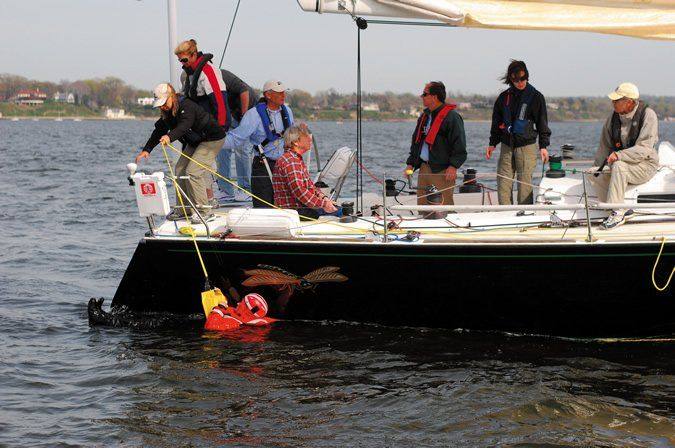
Over the years it has become clear that operator error is the major cause of most boating accidents. It can be an error of omission or commission, but when the result is an out-of-control scenario, the end state often includes vessel damage and/or personal injury. Factors such as boat speed, sea state, and crew expertise interact in a way that defines where the in-control boundary ends. This a measure that varies among sailors, and its an awareness that a skipper must treat with the same respect that a race car driver gives the redline on his tachometer.
The headline in a recent press release read as follows; Clipper Round the World Yacht Race: CV 30 Great Britain-Simon Speirs passes away after being washed overboard. It was a dj vu account of the tragic deaths that occurred in the previous running of the Clipper Ventures event. We covered these unfortunate developments in a recent Renting Adventure the January 2017 issue of Practical Sailor. This time, another pay-to-sail crew member, equipped with all the requisite gear, (water-proof foulies, inflatable lifejacket/harness, tether and an Automatic Identification System alert beacon) went overboard and somehow became separated from the vessel. It took 36 minutes for the crew of the 75-footer to return and rescue the unresponsive victim. A similar crew overboard incident occurred in the 2015/16 Race along with the death of another crew member who was hit by the mainsheet tackle. The following comments come from the British Marine Accident Investigation Board (MAIB) findings about the earlier fatalities:
Effective supervision would have provided opportunities to prevent both accidents
Danger zones need to be clearly marked on deck
Given the uncertainty of successful man overboard search and recovery, particularly in atrocious weather, the need to clip on is paramount
Skippers need to be effectively supported and, where appropriate, challenged to ensure safe working practices.
The recent, tragic Clipper Ventures MOB fatality and the grounding and total loss of CV-24, another Clipper Ventures competitor, have raised even more questions about preparedness and risk mitigation. The initial details are in and a thorough investigation will certainly follow. But many of the preliminary comments are significant. According to Clipper Ventures, Simon Spiers had completed a four-week, hands on training program specifically focused on the safety aspects of the Clipper Race. It included practicing crew overboard recovery maneuvers and victim survival techniques. In addition, he completed the programs two-week long coxswain qualification program. His pre-race formalized training seems thorough, his equipage was state of the art, but his prior experience offshore aboard large ocean racers was limited.
Spiers sailing CV stretched back 40 years and focused mostly on dinghy sailing and some coastal racing in smaller keel boats. Cross decking to a 75-footer with a 3,100 square-foot sail plan with piston-hanking headsails, drastically changed the dynamics.
At speed in a seaway, those at the bow experienced pitch and yaw induced acceleration that went from a bow buried in green water to feeling airborne and weightless. The combination of a large sail plan and a big boat being driven hard significantly chips away at the safety margin. Of key importance is how effectively a skipper takes existing conditions and crew competency into consideration.
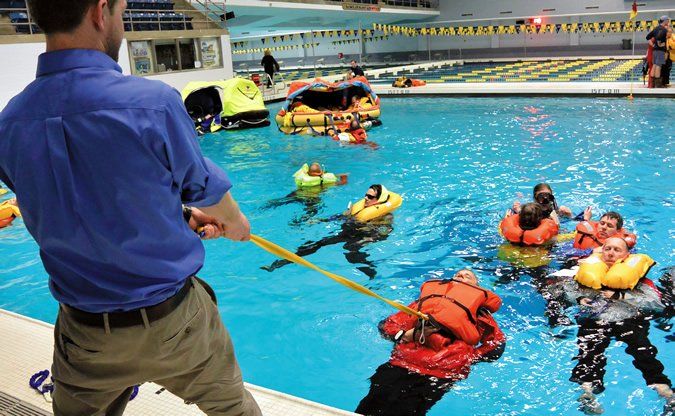
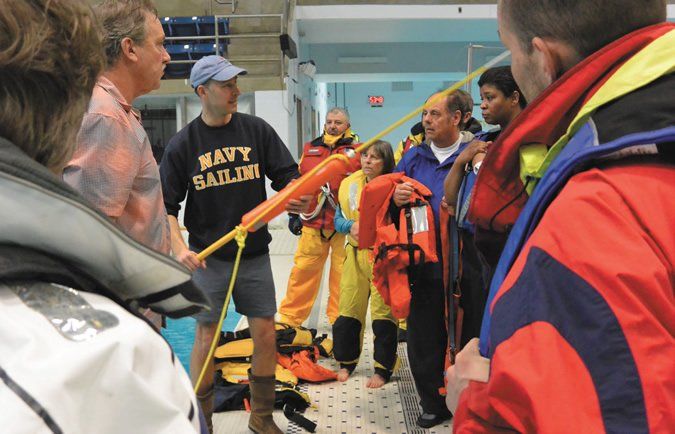
Mitigating Risk in the USA
US Sailing and World Sailing, the national and global governing bodies for the sport, have evolved useful guidelines for safety seminars, hands-on training and e-learning. Premiere iterations of these safety at sea programs are put on by the U.S. Naval Academy in conjunction with the Marine Trades Association of Maryland. The Cruising Club of America offers a specialized seminar thats fine-tuned to the Newport to Bermuda Race. The Storm Trysail Club has pioneered an innovative version of hands-on, on-the-water safety training. Nationwide, many yacht clubs and sailing schools offer one and two-day programs, many are US Sailing approved.
Common to all is the importance of incremental skill development-a belief in mastering seamanship in a coastal context before sailing off to Bermuda or Hawaii. Neither of these ocean routes are likely to be a sequel to the Great Southern Ocean or North Pacific, at least during the summer months. In short, the US Sailing approach to safety endorses incrementally gaining near-shore, coastal and offshore experience and engaging in formal safety training. Whats taught dovetails with the safety gear filling the aisles of chandleries across the country. US Sailing regularly updates their Safety Equipment Requirements for mono and multihulls. Its focused on ocean, coastal and nearshore racing. The goal is to require gear that helps prevent disaster or at least nudges things toward a positive outcome. (You can find sanctioned seminars at ussailing.org)
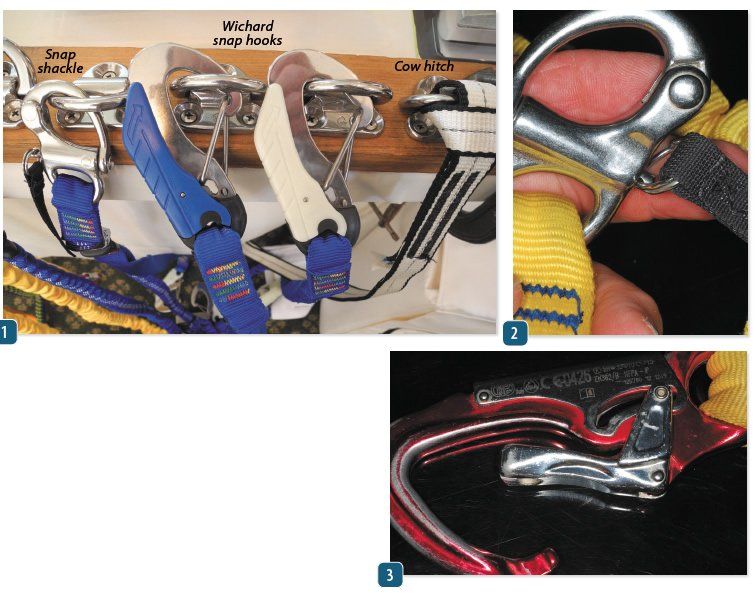
Gear Trends
Over the last several decades, inflatable lifejacket/harness combinations have established a strong foothold among sailors and their popularity continues to grow. A major feature is the comfort and convenience they deliver in their uninflated mode. This encourages sailors to wear floatation and indeed lessens the likelihood of drowning, especially in a flat water and calmer sea context. A growing concern, however, is the number of incidents involving heavy weather and/or struggles in the surf in which personal floatation devices (PFDs) have not lived up to expectations.
Historically, the U.S. Coast Guard had the job of rescuing the crews of vessel driven ashore by gales, storms or just plain poor seamanship. Cork, kapok, and eventually foam lifejackets have saved many lives. And if you look at U.S. Sailing reports of crew fatalities, you find a direct correlation between groundings in a surf zone and increased fatalities. (see the inside Practical Sailor blog posts on Low Speed Chase (Aug. 2012) , Uncontrollable Urge (Sept. 2013), and Aegean (Nov. 2013).
Despite this well documented risk, we learn through US Sailings report on the Uncontrollable Urge accident that at least one popular PFD harness used by offshore sailors today is prone to failure in surf conditions. According to the US Sailing report: four of five Spinlock Deckvests failed to work properly, allowing the flotation chamber to pull over the wearer’s head to one side of the body. The deceased was found floating face down with the flotation chamber pulled over his head. Given that the crew had to swim through large surf to reach the shore, this was a life-threatening failure. Some newer Spinlock Deckvests feature a different bladder design that makes this event less likely. According to company statements, the PFDs could not be expected to function perfectly in breaking surf.
If so, does this mean that prior to abandoning ship, you should ditch the inflatable and strap on a traditional Type 1 lifejacket? In many cases, yes. In an upcoming report in Practical Sailor, we’ll take a closer look at which PFDs are better suited for real world conditions that a coastal sailor is likely to encounter.
We’re not alone in our concern, the US Sailing panel recommended that Spinlock and other manufacturers examine the design of their inflating vests and consider making the inflation chamber more secure to the harness.
As a result, new inflatable lifejackets are being designed with less, or no space at all for ones head to shift laterally into the area between the harness webbing and the floatation bladder. Bladder seams are less leak prone and oral inflation tubes and securing cleats are more heavily reinforced.
Looking ahead to more testing, two distinct trends in inflatable PFDs is apparent-lighter PFDs aimed at coastal fisherman and near shore racing sailors. For this market, Spinlock has come out with some new products including their Deckvest Lite, a 170 Newton USCG-approved life jacket. Theres no harness feature with this vest, but it is a lifejacket thats easy to don and doff, comes with a crotch strap and theres an optional spray hood. The new Deckvest includes places to attach a PLB or AIS beacon and a pylon light is standard.
At the opposite end of the spectrum, is Mustangs EP 38, a bulky combination lifejacket/harness device with USCG approval. It has a hydrostatic inflator and a built in harness and removable crotch straps. Mustang points out in its literature what we have been advocating for years. Your PFD has a built-in harness intended for attaching to boats using a QUICK-RELEASE UNDER-LOAD tether… Do not attach to boats using any other means.
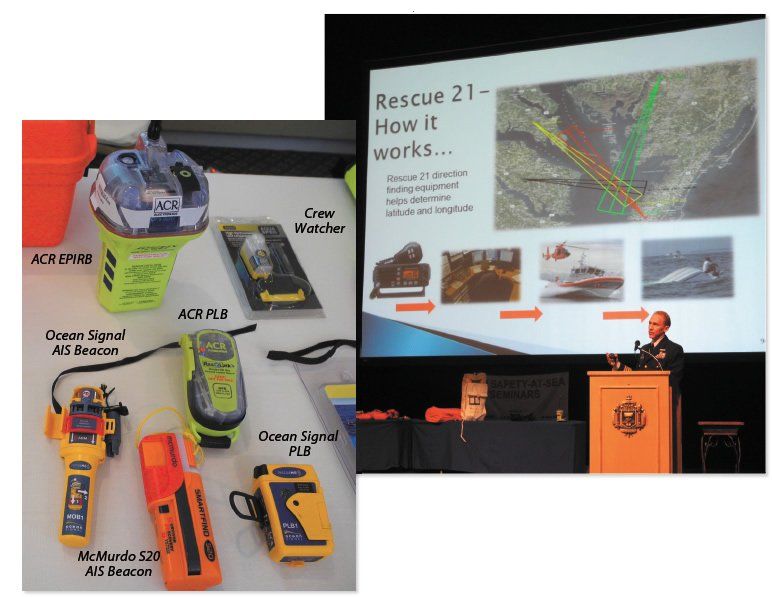
Tethers and Jacklines
Webbing remains the preference when it comes to jacklines, but in 2018 we are taking another look at other options in the wake of recent tragedies. One of the reasons webbing is preferable is that a tether clip under load is less willing to slip along a webbing jack line. Friction caused at the webbings wide surface area make the clip more reluctant slide. When a clip is secured to plastic coated wire, or small diameter high modulus rope, it is much more prone to slide. During a wave impact, this added friction helps to keep a crew in place rather than being washed aft. The flat webbing also tends not to roll or slide when stepped on.
In terms of safety tether, these too, deserve a closer look in 2018. For some time we’ve favored the double-action clips based on the Gibb design, since these were the easiest to open snap-hooks made of 316-grade stainless-steel locking clips to open. A similar stainless steel snap hook design is found on Wichard tethers, although sailors with weaker hands will find this double action, 316 SS clip difficult to open.
We look forward to testing Wichard’s newer Proline snap-hook, which is based on a mountaineering design. Wichard’s tethers, like most designed to meet World Sailings rules, features a two-meter long polyamide webbing that springs back to 1-meter in length thanks to the imbedded elastic. An overload indicator threads show whether the tether remains in spec. It also comes in a double clip (short/long) version.
Our current preference is the snap hook made by Italys Kong, with some caveats. This tether has a single-part elastic tether with a snap shackle at one end and a double action hook at the other end. Its lighter in weight, but the large jaw jackline clip is comprised of both aluminum and stainless-steel parts. Because of the mixed-metal construction, care must be taken to keep seawater for causing galvanic corrosion that can make the clip hard to open or close. Rinsing with fresh water after use and occasionally lightly lubricating the latch pivot pin makes a big difference.
Tether entrapment has contributed to several fatalities and comments from a survivor of the Wing Nuts capsize, were quite specific that he too would have drowned had a fellow crew not cut his tether free (See PS Analysis: The 2011 WingNuts Capsize, April 2011). Research into tether entrapment done in Australia concluded that tether release clips dubbed load off devices range from very difficult to impossible to operate. These clips require line tension to be removed prior to releasing. Therefore load on releasable clips, such as a high quality snap-shackle, is preferable when connecting a tether to a harness. The operative word here is high quality, because, as discussed in our 2011 analysis of the Wing Nuts accident, some snap-shackles fall short in key details and can be difficult to release under load.
Beacons and alarms
Some of the most notable improvements in MOB prevention has occurred in the realm of electronics. In the May 2008 issue of Practical Sailor we covered state of the art MOB beacon technology for that time. Some were simply proximity alarms that let the crew on board know when a shipmate had gone over the side. Other devices radiated an RF signal that could be crudely detected with a portable or fixed radio-direction finder (RDF) antenna and receiver. Though promising, these devices were a first step forward rather than a final answer to finding someone whos gone over the side.
Five years later, we looked at electronic beacons that took advantage of the Automatic Identification System (AIS), and third that used Digital Selective Calling (DSC) frequencies on VHF radio. Using built-in GPS for location finding, these devices greatly simplified the process of tracking a person in the water.
Today, new MOB alert and position finding electronics are again taking center stage and well look at three very different technologies. The first and best-known genre is the Personal Locator Beacons (PLB). These miniaturized EPIRBs work on the same 406 MHz frequency as their big brother, the EPIRB. When activated, they send a digital distress signal to multiple COSPAS/SARSAT satellite arrays, and its forwarded to a Local User Terminals (LUT) which sends it on to a Mission Control Center (MCC) and finally a Rescue Coordination Centers (RCC) which validates the signal and launches a search-and-rescue effort. The big up side of this technology is an alert is responded to by a worldwide network of rescue providers. The downside for the person in the water (PIW) is the time it takes to acquire, relay, authenticate, and set a rescue mission into motion.
This is further complicated by the fact that the crew aboard the vessel linked to the victim has no direct means of acquiring the position data being broadcast by the PLB. The net result is the PIW needs to be able to survive for the time it takes for rescuers to arrive. Offshore, well away from USCG vessels and beyond the range of rescue helicopters it becomes an even longer wait. Therefore, a savvy skipper with a sat phone should store essential phone numbers such as the closest USCG Rescue Coordination Center. For example, by dialing 757-398-6700 you get a 24/7 link to the USCG Atlantic Area SAR Coordinator. She or he can tell you if a PLB signal has been received from a crew member whos gone over the side. Its a circuitous means of getting a lat/lon fix, but if the MOB is out of sight and they have a functioning PLB, it is a process worth pursuing. For more PLB and USCG details, see www.dco.uscg.mil.
An AIS beacon provides another electronic alternative to finding an MOB. It puts the crew of the victims vessel and other AIS equipped boats in the area, into a primary rescue role. These compact beacons contain a GPS receiver, VHF transmitter, and some can be attached to an inflatable PFD so that the auto pneumatic inflation feature of the lifejacket also activates the AIS beacon.
This results in a VHF signal that causes an MOB icon to appear on an AIS display or on a larger networked digital chart display. Range and bearing data helps guide the crew back toward the real-time position of the victim. The range is dependent upon antenna height and sea state, and what most recent sea trials indicate is that a vessel with a masthead antenna thats 50- or 60-feet above the water attains a solid signal when within a 3-mile radius of the victim. The value of low loss VHF antenna cable, carefully soldered connectors and a low loss antenna splitter (see PS December 2013) become very important.
There are also AIS beacons that send out a DSC emergency signal like we tested in 2011. The latter instigates an alarm sound on the vessels VHF radio. Theres some concern that the potential CH 16 voice responses and VHF digital signals being received by the same VHF antenna may causes some interference, a topic worth studying in a future test.
In near shore waters, the DSC signal will directly draw USCG attention and they will take a primary communications role. But further offshore, the responsibility of rescue coordination shifts to the crew of the vessel reacting to their own MOB situation. In short, the AIS beacon is a worthy aid when a victim is beyond visual range, but AIS beacon reception is limited. Its sobering to note that in the recent November 2017 Clipper Ventures Race fatality, and in the MOB death in the prior race, the victims had an AIS beacon and the vessel returned and recovered both persons in the water, but neither regained consciousness. As many a pro sailor attest, you just can’t afford to go over the side!
Mark the spot
Many cruisers sail double-handed with one person on watch while the other is below in their bunk. The latest entry into the MOB market, the Crew Watcher, is an extremely compact device that works with a smart phone to locate crew in the water.
Crew Watcher is a MOB signaling device that links to an app on a smartphone or tablet. And if the person on deck falls overboard, the beacon submerges or loses the signal, an alarm goes off in the smart device tracking the beacon. The position, at the time of the incident, is electronically marked and the phone or tablet will show the bearing and distance to the original MOB position.
Naturally, the shorter the return time the more likely the victim will be in the same area. This is not an AIS or a PLB, but it does provide a crew overboard indication and a return course to the point of the MOB. Priced at $90, it puts an existing cell phone or tablet to good use. Naturally, charging the phone and making sure that its alarm sound can be heard over inherent boat noises (including the engine) is important.
Conclusion
Whether you’re a racer or cruiser, a primary safety investment should be in equipment that keeps you onboard, aids that keep you afloat and makes you as visually and electronically discernible as possible.
Of course, don’t forget about the value of effective nonskid on deck and ample, inboard handholds. Be sure the jacklines are tight, placed as inboard as possible and secured to strong points at the bow and at least six feet forward of the stern. When it comes to choosing a tether, make sure you opt for a double action clip at the distal end and a snap shackle-type release to connect to the harness.
Your inflatable life jacket may have a superb reputation for comfort on deck, but its how it works in the water that counts. Recent analysis of fatal groundings and capsizes indicate that in the worst of conditions, your chance of survival goes up if you are wearing a life jacket. But make sure that you annually inspect the lifejacket for bladder leaks and watch for manufacturer recalls and product advisories.
Buying an AIS beacon is only step one. The purchase puts you and your shipmates into the search and rescue drivers seat. Practicing how the data (range and bearing) will be used in the MOB recovery, where it will be displayed and how it fits in with your MOB recovery tactics. Practice is as important as the purchase itself. The bottom line-preventing an MOB incident is always better than executing a response.
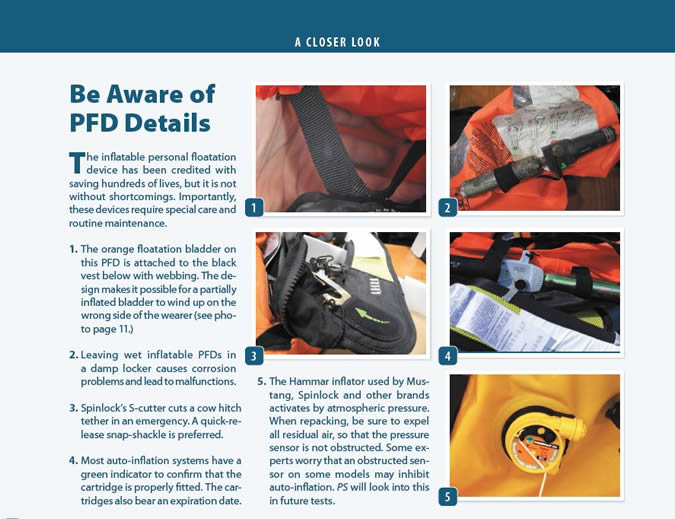
The inflatable personal floatation device has been credited with saving hundreds of lives, but it is not without shortcomings. Importantly, these devices require special care and routine maintenance.
1. The orange floatation bladder on this PFD is attached to the black vest below with webbing. The design makes it possible for a partially inflated bladder to wind up on the wrong side of the wearer.
2. Leaving wet inflatable PFDs in a damp locker causes corrosion problems and lead to malfunctions.
3. Spinlock’s S-cutter cuts a cow hitch tether in an emergency. A quick-release snap-shackle is preferred.
4.Most auto-inflation systems have a green indicator to confirm that the cartridge is properly fitted. The cartridges also bear an expiration date.
5. The Hammar inflator used by Mustang, Spinlock and other brands activates by atmospheric pressure. When repacking, be sure to expel all residual air, so that the pressure sensor is not obstructed. Some experts worry that an obstructed sensor on some models may inhibit auto-inflation. PS will look into this in future tests.


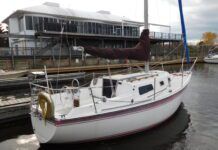



































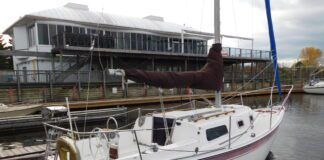
We need different items for different boating activities. The bigger the boat, the more items are necessary, but on a 15 foot boat which object is required to be on board?